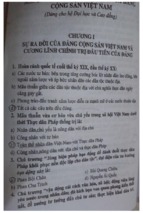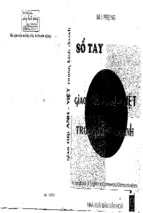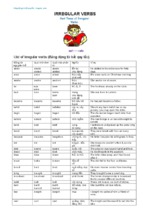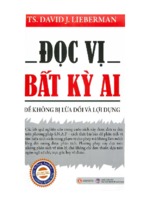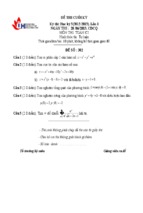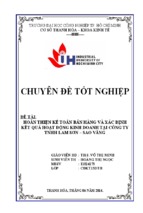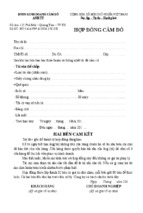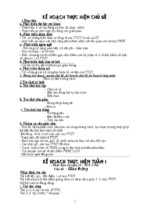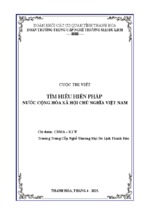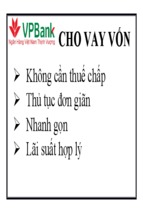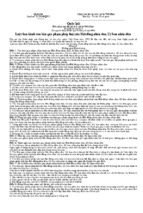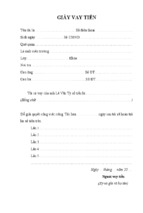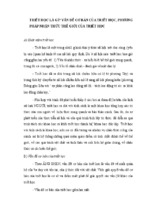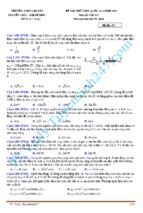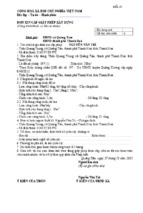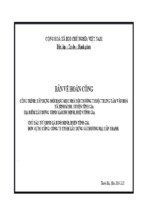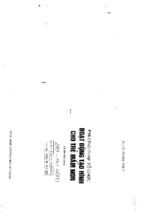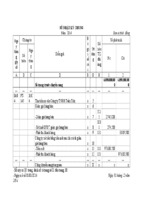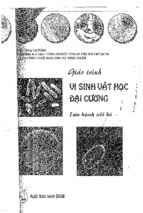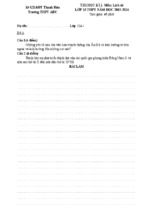2019 – 2021 (2)
ENGLISH LANGUAGE
MINISTRY OF EDUCATION AND TRAINING
HANOI OPEN UNIVERSITY
M.A. THESIS
LINGUISTIC FEATURES OF COFFEE ADVERTISING
SLOGANS IN ENGLISH AND VIETNAMESE
(Đặc điểm ngôn ngữ trong các khẩu hiệu quảng cáo
cà phê trong tiếng Anh và tiếng Việt)
PHAN THỊ MAI HƯƠNG
PHAN THỊ MAI HƯƠNG
Field: English Language
Code: 8.22.02.01
HANOI, 2021
MINISTRY OF EDUCATION AND TRAINING
HANOI OPEN UNIVERSITY
M.A. THESIS
LINGUISTIC FEATURES OF COFFEE ADVERTISING
SLOGANS IN ENGLISH AND VIETNAMESE
(Đặc điểm ngôn ngữ trong các khẩu hiệu quảng cáo
cà phê trong tiếng Anh và tiếng Việt)
PHAN THỊ MAI HƯƠNG
Field: English Language
Code: 8.22.02.01
Supervisor: Dr. LE PHUONG THAO
HANOI, 2021
CERTIFICATE OF ORIGINALITY
I, the undersigned, hereby certify my authority of the study project report entitled
“Linguistic features of coffee advertising slogans in English and Vietnamese”
submitted in partial fulfillment of the requirements for the degree of Master in the
English Language. Except where the reference is indicated, no other person’s work
has been used without due acknowledgment in the text of the thesis.
Hanoi, 2021
Phan Thị Mai Hương
Approved by supervisor
Lê Phương Thảo, Dr.
Date: ..................................
ACKNOWLEDGEMENTS
I would like to take this opportunity to thank all the following people for their great
supports during the time I carried out this research.
First and foremost, I would like to express my deep gratitude to Dr. Le Phuong Thao,
my supervisor, for her clear guidance, insightful comments, and dutiful supervision.
I would like to give my sincere thanks to all the lectures at Hanoi Open University for
their knowledge, experience, and enthusiasm in their lectures from which I have acquired
valuable knowledge and inspiration to fulfill this minor thesis.
Last but not least, I must express my gratitude to my family. It is their endless love and
expectations that have motivated me to complete this thesis. I am immensely thankful
for all the assistance they have given to me.
.
ii
ABSTRACT
This study focused on syntactic and semantic features of coffee advertising slogans in
English and Vietnamese to find out the similarities and differences between them. This
research used quantitative and qualitative approaches. A quantitative approach was
employed to obtain the frequency of the types of structures, and the types of meaning
conveyed through the selected slogans. And the qualitative approach was used to
describe and analyze the features of slogans from linguistic aspects. The data were in the
form of slogans used by different companies in English and Vietnamese. The results of
this research show that in terms of syntax, clauses, phrases, and simple sentences are the
most common structures used in English slogans, while Vietnamese ones focus on
clauses and sentences. These structures in general keep the slogans short, and easy to
remember, which are the key points in making marketing and creating slogans. In terms
of meanings, both English and Vietnamese slogans convey different types of meaning to
make a specific impression, but most of them express the conceptual meaning which
shows the direct meaning based on the dictionary. These results are meaningful for those
who are working in marketing, for lecturers who are teaching language, and for learners
who are studying English language, so that they can have different viewpoints about the
language used in advertising language in general, and in slogan in specific.
iii
LIST OF ABBREVIATION
AIDA:
A:
Attention, Interest, Desire, and Action
Adverbial
C:
Compliment
O:
Object
S:
V:
Subject
Verb
iii
LIST OF FIGURES
Figure 3.1: Types of English slogans in terms of syntax
30
Figure 3.2: types of Vietnamese slogans in terms of syntax
36
Figure 3.3: Types of English slogans in terms of semantics
40
Figure 3.4: Types of Vietnamese slogans in terms of semantics
49
vi
TABLE OF CONTENTS
CERTIFICATE OF ORIGINALITY ................................................................................i
ACKNOWLEDGEMENTS .............................................................................................ii
ABSTRACT ................................................................................................................... iii
LIST OF ABBREVIATION ...........................................................................................iv
LIST OF FIGURES.......................................................................................................... v
TABLE OF CONTENTS ................................................................................................ vi
Chapter 1: INTRODUCTION .......................................................................................... 1
1.1. Rationale .................................................................................................................. 1
1.2. Aims and objectives of the study ............................................................................ 2
1.3. Research questions .................................................................................................... 2
1.4. Scope of the study ................................................................................................... 3
1.5. Methods of the study ............................................................................................... 3
1.5.1.
Research approaches........................................................................................... 3
1.5.2.
Methods of the study .......................................................................................... 3
1.6. Significance of the study ......................................................................................... 4
1.7. Structure of the study .............................................................................................. 5
Chapter 2: LITERATURE REVIEW ............................................................................... 6
2.1. Previous studies ......................................................................................................... 6
2.1.1. Previous studies on English slogans ...................................................................... 6
2.1.2. Previous studies on Vietnamese slogans ................................................................ 9
2.2. An overview of linguistic features .......................................................................... 11
2.2.1. Theories of syntax in English ............................................................................... 11
2.2.2. Theories of syntax in Vietnamese ........................................................................ 15
2.2.3. Theories of semantics in English ......................................................................... 20
2.2.4. Theories of semantics in Vietnamese ................................................................... 23
2.3. An overview of advertising ..................................................................................... 25
2.4. An overview of slogans ........................................................................................... 27
2.4.1. Definition of slogan.............................................................................................. 27
2.4.2. Classification of slogans ...................................................................................... 28
2.4.3. An overview of coffee advertising slogans in English and in Vietnamese.......... 29
iv
2.5. Summary ................................................................................................................. 29
Chapter 3: ....................................................................................................................... 30
COMPARISON BETWEEN COFFEE ADVERTISING SLOGANS IN ENGLISH
AND VIETNAMESE..................................................................................................... 30
3.1. Syntactic features of coffee advertising slogans in English and in Vietnamese ..... 30
3.1.1. Syntactic features of coffee advertising slogans in English................................. 30
3.1.2. Syntactic features of coffee advertising slogans in Vietnamese .......................... 36
3.2.Semantic features of coffee advertising slogans in English and in Vietnamese ...... 39
3.2.1.Semantic features of coffee advertising slogans in English .................................. 39
3.2.2.Semantic features of coffee advertising slogans in Vietnamese ........................... 49
3.3. A comparison between coffee advertising slogans in English and in Vietnamese . 58
3.3.1. A comparison between coffee advertising slogans in English and in Vietnamese
in terms of syntax ........................................................................................................... 58
3.3.2.A comparison between coffee advertising slogans in English and in Vietnamese in
terms of semantics .......................................................................................................... 59
3.4.Summary .................................................................................................................. 60
Chapter 4: CONCLUSION ............................................................................................ 62
4.1. Recapitulation ......................................................................................................... 62
4.2. Concluding remarks ................................................................................................ 62
4.3. Limitation of the study ............................................................................................ 63
4.4. Implications and suggestions for further research .................................................. 63
4.4.1. For advertisers ...................................................................................................... 63
4.4.2. For teachers .......................................................................................................... 64
4.4.3. For language learners ........................................................................................... 64
4.4.4. Some suggestions for further studies ................................................................... 65
REFERENCES ............................................................................................................... 66
APPENDIX .................................................................................................................... 69
iv
Chapter 1: INTRODUCTION
1.1. Rationale
It is undeniable that nowadays, we can find ourselves be surrounded by advertising by
companies that keep telling us about their products and what should we do, or what
should we buy. Rajpal (2014), an anchor and correspondent for CNN International, wrote
that everywhere we go, everywhere we look, we are inundated with messages. That is
why the customers do not even have to think for themselves. All they have to do is to sit
on our comfy couch and be told how to live their lives, from how to look, what to wear,
what to eat, to drink, etc. That can be considered as the power of advertising. However,
this diversity also puts challenges to marketers. They need some devices that can catch
the customers’ attention, arouse their desire, and induce their action. And they realized
that slogan is a good choice. Slogans can be made in the form of short, catchy, and
creative sayings that leave an unforgettable impression on the potential customers’
minds. And to achieve that result, it requires a sophisticated linguistic insight of
phonology, lexicology, syntax, as well as semantics and pragmatics. As a result, it is true
to say that using language in advertising is a kind of art. There have been studies on
slogans of fast food, cosmetics, mobile phone, car, etc. but there have been no studies on
slogans for drinks, or coffee in particular. Realizing the missing here and the benefits of
understanding the method for generating slogans, as well as the syntactic and semantic
features of slogans towards those who are working in the marketing fields and those who
are finding documents and studying this topic, the writer decided to carry out a study to
analyze and compare the coffee advertising slogans in English and in Vietnamese to find
out the similarities and differences between them. The paper presents theoretical
background about previous studies in English and in Vietnamese on slogans in general,
as well as necessary theories about syntax and semantics, marketing, and slogans in
English and in Vietnamese, which will be used to analyze the slogans to draw out the
similarities and differences between them. The slogans analyzed in the study are
collected from different companies’ websites and the internet. The result of the study,
hopefully, will be beneficial for the marketers who are trying to seek and create their
slogans, and for those who are interested in the art of language in slogans. Theoretically,
the study provides a comprehensive understanding of the syntactic and semantic features
1
of the English and Vietnamese slogans. It is of great significance for anyone who desires
to study more about advertising language in general and advertising language for a
beverage in particular.
Practically, the results of the study value for those who intend to start their journey into
studying syntactic and semantic features of the language. It also helps English and
Vietnamese customers, who are interested in language, master linguistic features used
by marketers to advertise their products.
For the above reasons, the author would like to choose the topic “Linguistic features of
coffee advertising slogans in English and Vietnamese” with the attempt to find out the
similarities and differences between slogans in English and Vietnamese and draw out
the implications for further studies in the same field.
1.2. Aims and objectives of the study
This study aims at helping the readers, who are English and Vietnamese customers of
coffee companies and have an interest in language, master linguistic features of slogans
used by marketing writers to advertise their products. It is also helpful for further studies
on slogans by providing linguistic background theory.
In order to achieve the aim, the study is expected to reach the following objectives:
- To investigate syntactic and semantic features of coffee advertising slogans in
English and Vietnamese.
- To uncover the similarities and differences between the slogans in English and
Vietnamese in terms of syntactic and semantic perspectives.
- To propose some implications about linguistic features of language in advertising.
1.3. Research questions
This study is aimed at answering the following questions:
1. What are the syntactic and semantic features of coffee advertising slogans in
English and Vietnamese?
2. What are the similarities and differences of coffee advertising slogans in English
and Vietnamese?
3. What are the implications about language in advertising slogans for advertisers
who are working in marketing, for teachers and for English language learners in
learning English and Vietnamese coffee advertising slogans?
2
1.4. Scope of the study
This study looks at the syntactic and semantic features of the selected slogans, so it
presents related theories about syntax and semantics. In the framework of the study, this
thesis only focuses on slogans used for drinks, or coffee in particular, in English and
Vietnamese. 60 slogans, including 30 ones in English, and 30 ones in Vietnamese, were
collected from June 2021 to December 20021, from companies’ websites and social
networks in English and Vietnamese. Therefore, this research may not cover all slogans
about drinks in English and Vietnamese.
1.5.
Methods of the study
1.5.1. Research approaches
To reach the goal of the study, two main research approaches are used. They are
quantitative and qualitative approaches. According to Saville-Troike (1982), comparing
and contrasting are the two of the best ways to point out the features between different
objects. This process will reveal the similarity and differences features of linguistics
patterns and their meanings. Thus, contrastive linguistics with its associated research
method – Contrastive analysis – will be used as the primary research framework for this
study. For the comparison of the frequencies of patterns in the two languages under the
study, a quantitative analysis of the corpus is adopted. Under the quantitative method,
data have been collected for the study including both slogans in English and Vietnamese.
And the qualitative method is used to describe and analyze linguistic features of the data
in the study.
1.5.2. Methods of the study
1.5.2.1. Major methods
In order to achieve the aims are given, descriptive and contrastive methods are used in
the thesis. Firstly, the descriptive method is used to describe in detail the syntactic and
semantic features through the examples of English and Vietnamese slogans about coffee
collected from companies’ websites and social networks. Secondly, contrastive and
comparative methods are used to find out the similarities and differences in the syntactic
and semantics features through the examples of English and Vietnamese slogans used
by coffee companies.
3
1.5.2.2. Supporting methods
The supporting methods are analytical, synthetic methods, and others. To investigate in
detail the slogans in English and Vietnamese with their different features with various
structures and meanings, an analytical method is also employed, and then the synthetic
method is used for grouping them based on certain criteria. Moreover, quite a few
research techniques have been combined, such as statistics, componential analysis, and
contrastive analysis.
In conducting the investigation, setting up a regular consultancy with the supervisor for
guidance and academic exchange is a critical technique to find out the right direction for
doing the research successfully.
1.5.2.3. Data collection
Samples of data containing slogans taken from sources of English and Vietnamese
articles, social networks, especially from some branch’s websites. Besides, examples of
slogans used for presenting theories are taken from textbooks, articles.
The corpus used in this study is built on the following general principles regarding the
size, a number of languages, and sources: (i) the size of the corpus: Some data used in
this research consist of 30 slogans in English, and 30 slogans in Vietnamese; (ii) the
number of languages: The corpus in this research is considered as a bilingual corpus,
hence it contains the two languages: English and Vietnamese; (iii) the source of the
corpus: The data in this research are taken from contemporary works, grammar books,
newspapers, etc. on different sources.
1.6. Significance of the study
A slogan is a form of a verbal logo. It sums up what the meaning it stands for, the
specialty, the benefit, and the marketing position, and commitment. It is especially useful
to reinforce the branch’s identity. The way that people often prefer remembering and
reciting slogans to the doodling logos is proof that a slogan is more powerful than a logo.
Talking about slogans, we can realize the two basic purposes: first, to provide continuity
to a series of advertisements in a campaign, and second, to reduce an advertising message
strategy to a brief, repeatable, and memorable positioning. Therefore, thanks to this
research, language learners and language researchers can get a lot of advantages.
As a whole, it is hoped that along with the understanding of syntactic and semantic
features of these slogans in English and Vietnamese, this study can be a useful material
4
for learning and studying the beauty of language in advertising in general, and in slogans
in particular.
1.7. Structure of the study
This study consists of four chapters, excluding the appendixes and the references.
Chapter 1- Introduction: Presents the reason why the topic is chosen, the aims, the
objectives, the scope of the research, the significance, and the structure design of the
thesis.
Chapter 2 – Literature review: provides the readers with the literature review of the
research, which attempts to present the previous studies as the premise for this study;
the theoretical background including general understanding about syntactic and
semantic features of language; an overview of advertising and slogan in general, and
the chosen slogans for this study in particular.
Chapter 3 – A comparison between slogans used by coffee companies in English and
Vietnamese, presents syntactic and semantic features of slogans used by coffee
companies. It also presents the finding on how these slogans are impressive and easy to
remember.
Chapter 4 – Conclusion: restates the aims and summarizes how to research the
objectives. Furthermore, this chapter also presents the limitations of the research and
some suggestions for further studies.
References and Appendixes come at the end of the study.
5
Chapter 2: LITERATURE REVIEW
2.1. Previous studies
2.1.1. Previous studies on English slogans
Syntactic and semantic features of the language are common topics in language
researches. Many researchers have so far carried out researches into the language used
in advertising and provided the related profound concepts.
Bell (1991) said that there were some reasons making media language an interesting
topic to linguists. First, media uses language in a way that is also found in ordinary
speech. Second, media can cause a huge effect on the language used in wider society.
Third, the media language also reveals the status of society and culture. It also affects
attitudes and opinions of society through the way it presents people and issues. And last,
media use the kind of language that is intended for mass public consumption, which
means different people can analyze and understand those languages in different ways,
but they still make sense.
According to Cook (1992), advertising is everywhere in contemporary society. It is on
the street, in the shop, on the television, on the internet, etc. He stated that the languages
in advertising contained poetic creativity and the creativity in literature. And we can also
find language play and patterning, as well as the world of fiction in sitcoms and soap
operas, social and personal significance in pop songs. Through the study, he concluded
that there were fourteen outstanding features of advertisement. First, advertisements
include a variety of substances in an advertisement. Some of them are not used in
communication elsewhere. Second, advertisements are embedded in an accompanying
discourse. Third, advertisements are presented in short bursts to impress the customers.
Fourth, advertisements are multi-modal and can use pictures, music, and language, either
singly or in combination. Fifth, advertisements, in their use of language, are multisubmodel and can be used in writing, speech, and song. Sixth, advertisements contain
and foreground extensive and innovative use of paralanguage. Seventh, advertisements
foreground connotational, indeterminate, and metaphorical meaning. Eighth,
advertisements make dense use of parallelisms, both between and within modes (e.g. the
words rhyme). Ninth, advertisements involve many voices. Tenth, advertisements are
parasitic: appropriating the voices of other genres, and having no independent existence.
Eleventh, advertisements are often heard in many contradictory ways simultaneously.
6
Next, advertisements merge the features of public and private discourse and the voices
of authority and intimacy. Then, advertisements make extensive use of intertextual
allusion, both to other advertisements and other genres. Last, advertisements provoke
social, moral, and aesthetic judgments ranging from the most positive to the most
negative (they are ‘harmful’ or ‘beneficial’, ‘bad’ or ‘good’, ‘not artistic’ or ‘artistic’).
In an article, Skorupa & Duatepe attempted to provide the definition of advertising
slogans since there has been no uniform definition of the slogans exists in scientific
literature. The group of authors (2014) stated in the research that slogans were defined
as short, catchy phrases, related to a specific brand, which defines, presents, and helps
customers remember the key concepts of a brand or advertising campaign itself. They
point out several languages and rhetorical devices typical for advertising slogans like
capitalization, rhyme, alliteration, repetition, wordplay (pun), metaphor, and different
levels of analysis such as graphical, phonological, lexical, syntactic, and semantic levels.
In this study, Teodorescu (2015) found that researchers had analyzed the language used
in marketing communications and determined that subtle wording changes might affect
consumers’ behavior and shape buying habits. Since then concluded that advertising
texts make excessive use of positive words. Advertisements tend to convey positive
images and give the target audience a positive attitude. Prohibition and negative forms
are generally avoided. And the low level of overall cognitive terms, associated with high
use of positive emotions, may be related to the fact that advertisements are meant to
allure the audience, to induce a certain perception and attitude, and they appeal most to
the receiver's feelings than thinking. an extremely low score for self-reference terms (I,
me, my), when compared to the values for both formal and personal texts. And the use
of the personal pronouns 'you' and 'we' is meant to make the message sound warm and
affable, narrow the gap between the sender and the receiver, and make the audience
perceive the message as being designed to help and care for them. The advertiser acts as
his main concern would be to ensure the consumer's comfort and leisure, help him make
the best choice always in his interest.
Advertisement is the tool used by many companies to inform prospective customers
about their products and services. As stated by Pilátová (2015), our mind is more focused
on the visual part of advertisements therefore text and messages should be rather short
but they should provoke some kind of emotion and be memorable as much as they can.
7
For such a purpose, many companies create commercial slogans, short messages which,
however, are informative and memorable at the same time. Slogans are short text
messages that need to be kept simple; however, one word is usually not enough. Slogans
often use grammatical structures that would not be accepted anywhere else except for
advertising. This diploma thesis explores the structures, tools, and grammatical devices
are used in advertising slogans to increase the persuasive effect on consumers.
Asmukovich (2015) realized that in the last decades, the market glut of advertising
caused increased intention and interest in the linguistic aspect. Advertising texts are of
great value for the analyses from linguistic, sociologist, sociolinguistic, psychological,
ethnologic, and last but not least marketing points of view. Linguists are interested in the
language of advertising because they want to know how particular language works in
this type of discourse, which linguistic means are used here and how advertising
language is changing in the course time. Specific linguistic features of advertising have
already drawn the attention of many linguists. In the opinion of the writer, several
advertising formulas are in existence today but one of the most commonly used is the
acronym AIDA. This refers to specific techniques necessary to implement when creating
an ad. The phrase AIDA, in marketing communication, was coined by American
advertising and sales pioneer Lewis in the late 1800s. The model talks about the different
phases through which a consumer goes before going to buy a product or service.
According to him, most marketers follow this model to fetch more consumers for their
products. Marketers use this model to attract customers to purchase a product. This
model can be seen widely used in today’s advertisements.
According to Alozie (2020, a slogan in simple description is a word, a phrase, or even a
sentence that is catchy, easy to remember, read, say, memorize, and translate. Every
slogan contains linguistic and semiotic inscriptions which try to arrest the attention of
the people. And the T-shirts which are adorned and designed with different forms of
slogans can be used to achieve different discourse illocutionary effects. The different
drawings, paintings, and writings on the T-shirts create different metaphorical images
and semantic features that can be better interpreted with multimodal discourse analysis.
The syntax of the words or sentences as the sample T-shirts used is totally influenced by
the assumptions of pragmatics. This is why most T-shirts suppress the subjects of
sentences, appear in phrases, adopt poor collocations and also allow usual graphitization.
8
It is abundantly clear from this paper that the slogans of T-shirts are generally
informative, expressive, and instructive. They are used to perform different types of
illocutionary actions which cause different forms of perlocutionary reactions.
2.1.2. Previous studies on Vietnamese slogans
Dang Thi Thao Quyen (2013) wrote that in her study that according to the concept of
communication theory, advertising is a verbal act and a process, true language
communicator. This is a type of mass communication, a monologue about pictures
awareness but the dialogue about the content with the aim of persuading the receiver of
the advertisement (consumers) to use their goods or services. This is what makes a huge
difference between one advertising discourse and another.
Pham Thi Cam Van (2003) said that in her study, advertising first appeared in Western
countries and was rooted in a Latin word, which meant attention, entice, allure.
According to the Vietnamese dictionary complied by Hoang Phe (2010), advertisement
(quảng cáo) is understood as the presentation or the mass introduction of a product that
aims at popularizing the product and finding more potential customers. According to the
writer, advertising language is one full of flexibility, variety, and creativity, therefore, it
is difficult to categorize it into a clear language style among the ones recognized by the
linguistic researchers. But there are some unique features of advertising language
including convincing which based on consumer psychology that they want to buy high
quality and might have the chance to buy the products with extra gift or something else;
interest/ impression that can be combined with the image, sound – those things can evoke
the enthusiasm, and the faith in the customers; poetic and literature features – that can
win the hearts of the customers; being brief and concise – one of the required features
of advertisement.
Phuong (2012) realized that from the writer’s perspective, television advertising has
many functions, including the function of introducing and encouraging customers to use
the manufacturer's products export; aesthetic function is the combination of language
and beautiful, and eye-catching images to attract viewers, arouses the desire to possess,
and make them want to buy the advertised product immediately; entertainment function
that can be seen in funny and interesting advertisements on television, helping viewers
feel comfortable and relaxed after stressful working hours. In the study, the writer stated
that words and phrases are two factors often used in TV commercial advertisements.
9
Nguyen Thanh Tung (2009) stated in the study, advertising was born in a certain social
situation when a private company or a large manufacturer launches a new product, they
need to establish a relationship between the market and the goal of selling the product
(this market is well understood). The fastest way for a large market is to introduce this
new product through the mass media to consumers with your product or service.
Advertising was born really as a bridge between producers and consumers. So the
activity of advertising aims at popularizing the branch, and encourage the customers to
buy or use a service. In terms of content, the main functions of the advertisement are to
convey the information and foreground the good quality to impress the customers. In
terms of format, advertisement seeks the attraction and impression by language, images,
sound, and colors.
Tran Thi Thu Hien (2012) combined linguistic and economic knowledge to analyze and
compares the advertising language in the printed press in Vietnamese and English to find
out the stylistic features of the Vietnamese advertising language in terms of vocabulary,
meaning grammar, and text. Through its stylistic features, the study locates the
functional style of advertising - which has so far not been agreed upon. She also
identified a new type of metaphor - allegorical metaphor - created from the combination
of grace under the traditional perspective and advertising images of modern technology.
In addition, there are three typical categories of contrasting rhetoric, which are reflexive,
inverse, and double syllable often used in Vietnamese advertising.
From the advertising collected, the writers concluded that most of the Vietnamese
expresses in the late 19th century and early 20th century has the introduction of books
and press in the advertising section. And the quantity of these introductions changed
yearly. The prominent style used in this advertising is in the form of verbal that create a
strong effect to focus customers’ attention on the name of products first, then the price.
Overall, there are some previous studies on advertising in general, and slogans in
particular. They prove that slogans and advertising in different fields are interesting
topics in linguistics. The topics mentioned in these studies are extremely diverse. It can
go from media language and its effects on society to advertising language and its poetic
features, then the advertising and the devices used in this type of language, or its power
in affecting consumers’ behavior and buying habits, etc. However, most of them are
focused on food, cosmetics, commercial advertising. Therefore, the writer decided to
10
combine theories and features presented in the previous studies to carry a research on
coffee advertising slogans in English and in Vietnamese.
2.2. An overview of linguistic features
2.2.1. Theories of syntax in English
According to Chomsky (1965), the syntax is the field of study that looks at the principles
and processes that sentences are constructed in particular languages. The aim of the
syntactic investigation is on the construction of grammar that can be viewed as a tool of
some sort for creating the sentences of the language under analysis. More broadly,
linguists must be concerned with the problem of determining the fundamental underlying
properties of successful grammars. One function of syntactic theory is to present a
general method for selecting a suitable grammar structure for each language, given a
corpus of sentences of this language.
Finch (2005) wrote that syntax is a term used for the study of the rules governing the
way words are combined to form sentences.
According to him, the words in English sentences are arranged in a specific order that
we cannot put in the arrangement we like if we wish to be understood. Moreover,
changing the word order can lead to a change of meaning. For example, in the sentence
“The cat chases the mouse”, each item is related to each other in such a manner that
allows only one interpretation. If we swap the items, such as “The mouse chases the cat”,
a totally different meaning is created. The reason is that each part in the sentence is
related to one another structurally, and this structure is reflected in the word order. In
some languages, the structure depends not on word order, but on the form of the words
themselves. In such cases, it is possible for sentences with a completely different word
order to mean exactly the same.
Richards and Schimidt (2010) stated that syntax was a major component of the grammar
of a language (together with the lexicon, phonology, and semantics). It answers the
question of how words are combined to form sentences and the rules which govern the
formation of sentences, making some sentences possible and others not possible within
a particular language. The interface between syntax and morphology (for example, the
rules for modifying words to reflect their grammatical roles in sentences) is called morph
syntax. One of the major goals of linguistics is to identify the syntactic rules of a
language and to provide descriptions that group together those words in a sentence that
11
- Xem thêm -


